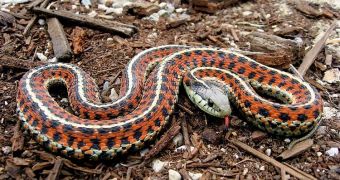Canadian researchers from the University of Waterloo have determined in a new study that snakes have the ability to boost their vision when they are threatened. The reptiles are able to accomplish this feat by controlling their blood flow, and redirecting it towards their eyes.
It could be that snakes developed this mechanism due to the fact that they have relatively poor eyesight in general. This is one of the reasons why they stick out their tongues into their environment, to collect more intelligence on their surroundings.
Though the creatures seem content with their poor eyesight in their everyday lives, researchers found that a defense mechanism kicks in when they are under attack, or otherwise threatened. By forcing more blood into their eyes, snakes momentarily see the world as well as their eyes can allow.
The investigation, details of which appear in the latest issue of the esteemed Journal of Experimental Biology, was funded by Natural Sciences and Engineering Research Council of Canada. Study researcher and team leader Kevin van Doorn conducted the work on Masticophis flagellum.
M. flagellum, also known as the coachwhip snake, ranges across the United States and Mexico. It comes in a variety of colors, from brown to pink, and features a very thin body, hence its name. The snake is not venomous, so researchers found it very easy to work with, LiveScience reports.
During a routine study, van Doorn noticed a series of small blood vessels networked in the eyes of coachwhip snakes. Upon closer examination, he noticed that these vessels were constricting and dilating in a constant rhythm, even when the snakes were sleeping.
However, when the creatures perceived some kind of danger – such as when researchers approached their location – they stopped this rhythm, and reduced blood flow through the venous network by as much as possible for a few minutes.
The research team believes that the snakes do this in order to be better able to determine the degree of threat they are faced with, and to figure out if they should attack or run. After the dangerous situations passed, their ocular blood vessels resumed their normal contraction/dilation cycle.
“This work shows that the blood flow pattern in the snake spectacle is not static but rather dynamic,” the lead researcher concludes.

 14 DAY TRIAL //
14 DAY TRIAL //